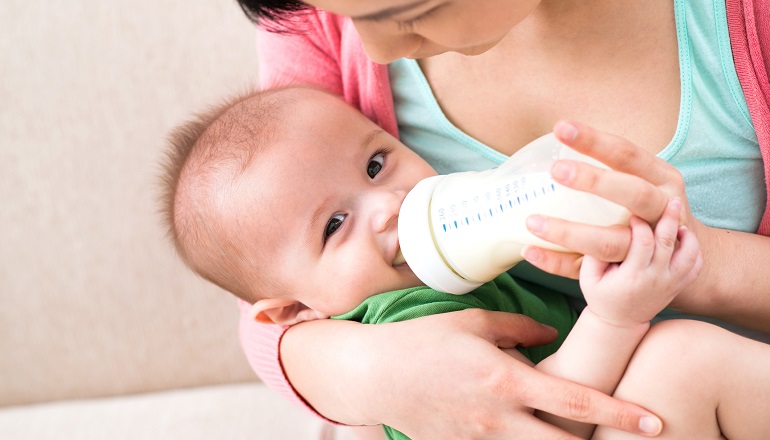Don’t you wish that infants came with an instruction manual? The good news is that you will learn much about your new arrival through trial and error. At the same time, these tips will help you to navigate those first days together, so that you can focus on what is most important: building a lifetime relationship between parent and child.
Choosing and Preparing Formula
During her first months of life, your infant will consume only formula. (Most pediatricians recommend holding off on solid foods until about six months of age.) Infant formula is available in three versions: ready to feed liquid (no dilution needed), concentrated liquid (that you mix with an equal amount of water), and powdered. Powdered is the least expensive, and, for most families, the most convenient, since a bottle can be prepared anywhere. If you have public tap water (as opposed to a cistern or well water), it is not necessary to boil the water or to use bottled or nursery water.
Most infants will take formula at room temperature. If youd like, you may heat it slightly in a pan of warm water. A microwave should never be used to warm a bottle, as it heats unevenly and could create hot spots. To check the temperature of the bottle, shake a few drops on the inside of your wrist.
It’s fine to use bottles that are glass or plastic, or those that have plastic liners. Nipples come in multiple styles, including silicon and latex. Use trial and error to determine what your child prefers. If you have tap water, you can wash the bottles in the dishwasher or by hand, rather than boiling them between uses.
Feeding from Start to Finish
How much and how often should you feed your infant? Most newborns will take two to three ounces per feeding by the end of the first week of life, and eat every three to four hours (or six to eight times a day). A good rule of thumb is that an infant needs two to three ounces per day for each pound of weight. Avoid feeding more than 32 ounces of formula in a 24-hour period. If your baby cries or fusses before her next feeding, don’t assume she is hungry. Try to comfort her in other ways first, like rocking her, walking with her, cuddling, and singing to her. Many infants enjoy sucking on their fists, their thumbs, or a pacifier as a way to calm themselves. Here are more guidelines:
Position is key: Never feed your baby lying down on her back, as this increases the risk of choking. Hold her in your arms, propping her up and supporting her head. Allow the formula to fill the neck of the bottle, so that she does not swallow air as she sucks.
Make a connection: Besides providing nutrition, use feeding sessions as a time to build attachment. Connect and have fun with your child: Speak or sing to her, and make eye contact. Mealtimes allow your infant to enjoy your body warmth and to associate the act of eating with being close to her parent. Turn off the television, and feed in an area free of distractions.
Look for cues: Infants will let you know they are done eating by turning their heads or pushing the bottle away. An infant starting to sleep through the night may take a larger bottle for the first one or two feeds each day, and require less formula throughout the rest of the day. Dont push feedings if she is not interested. You will know she is getting enough to eat by watching what comes out the other end. Most infants have six to eight wet diapers a day. Most have bowel movements daily (often after each feeding for the first few weeks), but this may vary after the first month or two.
If, as you go: Spitting up is not uncommon, especially in younger infants. If an infant takes in more formula than her small stomach can hold, she may spit up a large volume of fluid. If this happens, try feeding smaller amounts of formula more frequently. It may also help to burp her after every two to three ounces from a bottle.
You can burp your baby by holding her over your shoulder, sitting her on your lap leaning forward (support her head!), or laying her down on your lap. Some parents gently pat the back, others rub the back in a circular motionwhatever works for your infant. Talk to her as you burp her, to keep her from startling. Infants do not need to be burped after every feeding, but if your baby cries after she eats, or seems uncomfortable, try burping her. If she develops hiccups, stop feeding, change her position, and burp her. If the hiccups continue, wait a few minutes before feeding again.
As you and your baby will discover, feeding is a great way to promote bonding. Satisfy her hunger on her timetable, not yours. Associating this need with her needs for warmth, affection, and nurturing will help you to promote a lifelong attachment. Most important, enjoy this timebefore long, your infant will be ready for her first bites!



